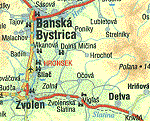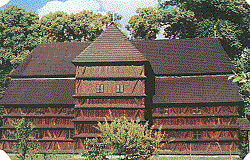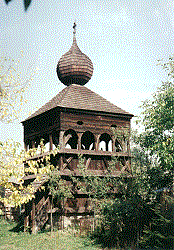|
|

slovensky

Association
of historic
towns and villages
|

Hronsek
|

|
|
Attraction highlighting: Gothic-renaissance castle, Soos-Géczy castle, Wooden church
|
|
|
|
 | | click for bigger map |

The parish Hronsek lies between the towns Zvolen and Banská Bystrica along the banks of
the river Hron. Its attitudes is 310 m a.s.l. First historical reports of Hronsek go
back to the year 1250.
The oldest historical building was built in 1576, it is a gothic-renaissance castle
and its fortifications, water moat, strong protective wall and four turrets were specially
build in defence of the Turkish invaders.
During Rákoczy rebellion coins were minted here. Juliana Korponay-Géczy (The White Lady
of Levoča), the daughter of Zigmond Géczy , mentioned in Mór Jókai´s roman lived
there.
In 1775 another castle Soos-Géczy was built nearby in baroque style with
four imposing corner turrets. The front facade has rococo details. Its interior has
interesting Prussian vaults. In the garden surrounding the castle stands a two hundred
year old lime-tree. It is 25 m tall and at 1 m height is 500 cm circumference.
It is known as the most beautiful species in the Middle Hron Region.
Points of interest, remarkables and rarities


|
|
wooden articular evangelical church
|
However, the articular wooden church is also a rare historical jewel as well as its
separate wooden belfry. The history of the church itself reflects back to the period of
strong catholic influence prevailing and its pressure against the Protestant religion.
Only, when Count Imrich Tökoly from Kežmarok came onto the scene, with the support of
the common people the Turkish invaders and French court rose up against the Austrian
Emperor Leopold I. They forced him to call the Šopron Council in 1681 and to reconsider
the Vienna Peace Treaty which was confirmed in 1606 regarding the freedom of the
Protestant religion. Thus, permission was granted for two churches to be built in every
district (in Zvolen region-Ostrá Lúka and Hronsek).
For example Articles 25 laid down the following conditions:
- Construction had to be completed within one year
- To be built exclusively from wood without iron nails
- No steeple was allowed
- No direct access from the road allowed
The construction of the wooden church commenced on 23rd October 1725 and consecrated on
the 31st October 1726 on Martin Luther´s reformation anniversary. The nave has the form
of a cross and is 8 m high, 26 m in length and 11 m wide. There are 30 windows. Vaults
are barrel shaped, ionic columns are made from oak with decorative carving. Spruce and
larch is used for other parts of the interior. The lower edge of the gallery has
carved ornamentation, with the typical Slavism symbol - limeleaves.
The church has 1100 seats arranged amphitheatricaly. In 1754, Master Martin Podkonický
from Banská Bystrica constricted the splendid organ (positive - without pedals). The
separate belfry was built at the same time as the church, it has three bells. In front
of the church stand four old time lime-trees, two of them are the same age as the
church itself.

|
|
wooden belfry
|
|
|